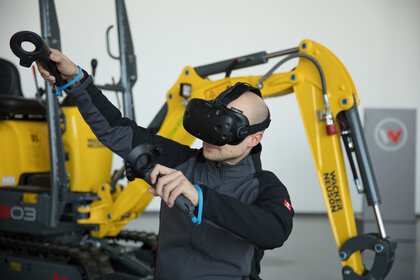Construction machinery industry: Shaping digitization
Digitization is working its way deeper and deeper into the construction machinery industry. For one simple reason: Construction sites themselves are increasingly becoming more digital. The aim of construction machinery development is to turn the potential of new technologies into practical solutions.
Digitization is one of the major trends shaping the construction machinery industry. State-of-the-art excavators, cranes and bulldozers are equipped with a broad range of sensors and communication interfaces. The data that is produced by this equipment and then analyzed makes it possible to check the machinery’s on-the-job performance, fuel consumption and locations, to define predictive maintenance, to more precisely determine operating costs and to manage entire fleets via telematics. Digitization also facilitates efforts to automate work processes, an increasingly important factor in light of the shortage of skilled workers faced by the construction industry. “For instance, the driver of construction equipment today can call terrain models that can be partially driven autonomously,” said Wolfgang Lübberding, Business Unit Manager of the Association of the Construction Industry, Environment and Machine Technology (VDBUM e.V.).
Joint digital understanding needed
Looking ahead, Lübberding said the industry faced the urgent task of enhancing connectivity and communication among models made by different producers. In addition, he said an agreement must be reached on the most uniform interfaces and data exchange formats as possible. “One step in this direction is ISO 15143-3. We have turned it into a global standard with the help of the Technical University of Munich and partner trade associations in the United States,” Lübberding commented. In the German Mechanical Engineering Industry Association (VDMA e.V.), machinery producers, construction companies and other actors are working to create a uniform digital understanding. “New business models are being developed in the process because data will become a more important financial parameter in the future,” said Dr. Darius Sossdorf, an expert in technology and standards at the Construction Machinery Association of the mechanical engineering group.
Standardized operator guidance
An even bigger area being addressed by designers of construction machinery is the arrangement of controls and operating units. “New functions, operating systems and additional communication and documentation tasks will enhance the complexity of the driver’s cab,” said Professor and Engineering Doctorate Frank Will. “Assistant systems that are actually designed to simplify operations will result in new control elements and displays. They will increase the demands on the operator in the process.” Will, the endowed chair of the construction machines at the Technical University of Dresden, sees two ways out of this dilemma: intensified use of training simulators and standardization of operator elements and control logic. To address the latter issue, the Cluster HMI, an alliance of machinery and component producers, construction companies, trade associations and universities, was established in September 2018. Its mission is to create the first standards for operator guidance, pictograms and control architectures. “The aim is to lower company development costs and, above all, to reduce the learning time that employees need when switching between machinery,” the professor said.
Photo material: © Wacker Neuson

